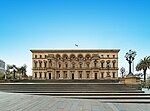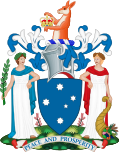Alcaston House

Alcaston House, located on the corner of Melbourne's Collins and Spring St, rises seven levels over a basement, and is one Melbourne's first mixed-use Art Deco buildings. It was designed by the firm of architects, A. and K. Henderson and erected by T Donald and Co. in 1929-30. The Renaissance Revival complex was erected for the trustees of Dr EM James, whose home previously occupied the land. Located at 2 Collins St, Melbourne; it is amongst is an early example of multi-storey residential accommodation in the city at a time when the post-war preference for flat living in Europe and the USA was becoming manifest in Australia. The art deco building is directly opposite the Old Treasury Building and Victoria's Parliament Building.
Excerpt from the Wikipedia article Alcaston House (License: CC BY-SA 3.0, Authors, Images).Alcaston House
Collins Street, Melbourne Melbourne
Geographical coordinates (GPS) Address External links Nearby Places Show on map
Geographical coordinates (GPS)
| Latitude | Longitude |
|---|---|
| N -37.81304 ° | E 144.97361 ° |
Address
Alcaston House
Collins Street 2
3000 Melbourne, Melbourne
Victoria, Australia
Open on Google Maps










